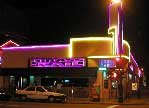 Here you go! An enjoyable guided stroll to take along as you wander around the heart of Hillcrest. Start or stop anywhere along the way on this flat, one-hour loop tour through history.
Here you go! An enjoyable guided stroll to take along as you wander around the heart of Hillcrest. Start or stop anywhere along the way on this flat, one-hour loop tour through history.

1. Hillcrest Sign. This neon sign was donated to the neighborhood by local businesswomen in 1940. Originally hung from large wooden posts, the sign has seen numerous updates over the past six decades including a rebuilding/relighting in 1984 and an addition of post decorations in 1994. Just down the street, another vintage neon sign marks Jimmy Wong’s Golden Dragon — the neighborhood’s oldest ongoing restaurant.

2. Guild Theater. 3825 Fifth Avenue. An example of early Spanish Revival architecture, the original Hillcrest Theater was constructed on this site in 1913 and was open for only four years. (We’re still researching why.) This sweet little movie house with a cozy balcony was reopened by Fox in the 1930s. (George Pernicano moved in next door after the war.) Following a renaming to the Guild in the late 1950s, it declined over the next several years along with the neighborhood. In the 1970s it was a comfy place to watch pornography before (in 1978) Landmark Theaters transformed it to show art films. San Diego’s last theater with a balcony stopped popping corn in 1997. A 2002 conversion to retail space replaced the entire structure, but reconstructed the facade based on the original design.

3. The Brass Rail. Hillcrest’s first gay bar. It was originally located across the street to the north where Washington Mutual Bank now stands (see HQ5 for an article about the Brass Rail’s history). The art deco neon piping is echoed across the intersection at the former site of the Chicken Pie Shop, a neighborhood icon for 61 years. The present coffee shop has occupied this corner since 1994.

4. All Saints’ Episcopal Church. Pennsylvania & Sixth. Built in 1912 this building is another early example of the architectural trend towards Spanish Revival designs, which would soon characterize much of nearby Balboa Park. The church had been established at this location for over a decade when William Hebbard (1863-1930) and Carleton Winslow (1876-1946) were commissioned to design a larger sanctuary. Hebbard, a successful local architect, was an early advocate of Mission Revival, a movement that would gradually supplant Federal and Neo-classical styles for Southern California civic buildings. Hebbard’s apprentice for the project was Carleton Winslow who went on to employ the same Spanish Colonial style for his next project – designing many of the buildings for the 1915 Panama-California Exposition in Balboa Park.

5. The Wednesday Club. Widowed at the age of 38, Hazel Wood Waterman set out to learn drafting, first through a correspondence school and later by working at the architectural firm of Hebbard and Gill. In 1910, The Wednesday Club, a woman’s civic group, commissioned her to design their new center. The simple horizontal lines of the building reflect the influence of her training with Irving Gill. Artisan craftwork (mostly by women) is incorporated throughout the inside of the building and is visible on the outside in the nautical inspired facade tilework.

6. The Design Center. 3611 Fifth Avenue. An example of early modern architecture tucked into a green canyon. Designed by Lloyd Ruocco (1907-1981) in 1949, this building housed the architect’s studios along with his wife’s interior decorating business and showrooms. These showrooms were the first to introduce modern furniture to San Diego. Since the Rouccos departure, the offices and studios have been used by a string of architectural and design professionals. Illustrators for the magazine Popular Psychology once worked here. From the street, the one story building blends well with the streetscape. The three-story rear of the building is faced in glass and flying walkways.

7. Merkley-Mitchell Mortuary. 3655 Fifth Avenue. Founded as the Merkley Mortuary in 1917, this building was once located four blocks to the north on what are now the grounds of Scripps Mercy Hospital. In 1928 (four years after Mercy Hospital opened) W.H. Mitchill, perhaps sensing that a bit more separation was appropriate, hired a team of horses to drag his business down Fifth Avenue to its present site. The Art Deco facade was applied soon after. In 1941 Merkley invited Warren Austin into the business which became the Merkley-Austin Mortuary. The Merkley-Mitchell Mortuary sign dates to 1968 when Richard Mitchell acquired the business. Since 1997 the mortuary has been managed by the Alderwoods Group which operates over 800 funeral homes throughout North America.

8. Hardesty House. 3695 Third Avenue. This classic Queen Anne style residence was an exuberant varient of the more restrained Victorian styled homes. The 1880s and 90s were the height of fashion, but already losing favor when this house was built in 1905.

9. Hall-Sherman House. 3720 First Avenue. Built in 1891 this simple Queen Anne is one of the oldest surviving residences in Hillcrest.

10. First Church of the United Brethren in Christ. 321 Robinson Avenue. This 1912 classic Greek Revival temple is a rare example of granite construction in San Diego. In 1950 the building became a Free Methodist Church. George Thackeray operated an art gallery specializing in Western and Indian art at this location from 1971 to 1988. Conversion to residential units was completed in 2003.

11. Whistle Stop. This hobby and train store has been at this location since 1949. Next door is the art deco Mubro Building. John’s Fifth Avenue Luggage on the other side of Fourth Avenue was indeed once located one block over.

12. Mercy College of Nursing. Built in 1926 this Mediterranean Revival building housed classrooms for student nurses. The nursing school was established in 1903, originally located adjacent to St Joseph’s Hospital at Eighth and University. In 1924 both the hospital and nursing school relocated here. The school shutdown in 1970 after graduating 1,550 nurses over 64 years.

13. Urban Outfitters. This federal brick building was rumored to be as the Hillcrest station of the U.S Postal Service (actually it was located across the street just north of the historic bank building, but it’s been razed, and the post office was relocated to Cleveland & Blaine in 1978.) In 1987 Lesley & David Cohn developed the building as a 1950’s era diner, before that this cavernous interior saw use as a community center. Across the avenue is Village Hillcrest, (started in 1991 & finished the following year) this mixed-use development features 705 underground parking spaces. Prior to Village Hillcrest the site was occupied by W.W.Whitson’s Hillcrest Bowl until the late ’70s.

Skyline of the heart of Hillcrest as seen from the southeast. The microwave antennae at AT&T are visible to the right. Just to the left of the ATT tower is Scripps Mercy Hospital, Continental Rehab and Village Hillcrest. The UCSD Medical Center can be located to the northwest (the upper left.)
